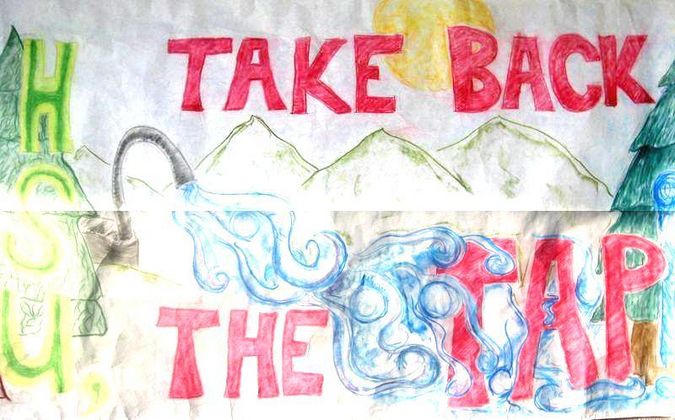
History
Formation of Take Back the Tap at HSU
The purpose of this page is to educate the public about the Humboldt State University chapter of the national organization Take Back the Tap. Humboldt State, a four-year California State University located Arcata, consumes approximately 80,000 plastic bottles of water annually.[1] In an effort to stop the use of plastic water bottles, HSU students from the spring 2009 Environmental Science Capstone class began a campus affiliate of Take Back the Tap at HSU. Take Back the Tap, or TBTT, is a national organization with many student chapters at campuses across the country. The HSU TBTT section is funded by Humboldt Energy Independence Fund, or HEIF. HEIF is an organization sustained through strong student involvement and works to finance student-run projects aimed at reducing environmental impact. From grant-writing to campus events, HSU students participating in TBTT are actively seeking and developing methods to eliminate the use of plastic water bottles and to encourage hydration by filling up reusable containers with local tap water.
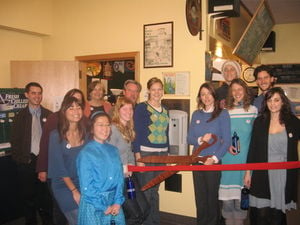
Structure of the Take Back the Tap Organization[2]
The Official Campus Club is organized as follows:
Co-Directors:
- Beth Oates and Amanda Platt
Coordinator Campus Recycling Program:
- Sarah Schneider
Active Members:
- Sue Muraoka, Gabe Salazar, Lindsey Lascheck, Alex Moser and Andrew Duenez
ENVS 411 Senior Capstone Group:
- Kylee Singh, Sarah Schneider, Melissa Pawson, David Shibley
Consequences of Bottled Water
Take Back the Tap's foundation is built on fundamental principles. Some of the reasons behind TBTT's fight to stem the production and consumption of bottled water fall under monetary, environmental, and health impacts.
Economic
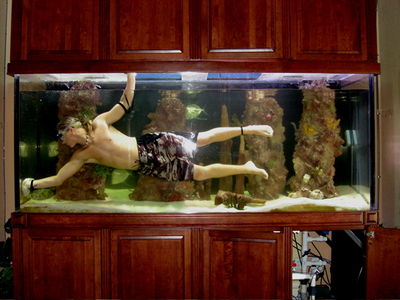
Consumers annually spend hundreds to thousands of dollars more on bottled water than water out of their tap. The cost of filling the 1000 gallon tank on the right can vary greatly due to the discrepancy between bottled and tap water: the average price for using tap water is about $2 per 1000 gallons and the average cost of bottled water ranges from $0.89 to $8.26 per gallon.[4] A cost for the fuel used to produce the plastic bottles also exists. According to the Pacific Institute[5], the United States' bottled water consumption in 2006 required over 17 million barrels of oil. That is enough to fuel more than one million cars and lightweight truck for a year. [5]In addition, the disposal of the bottle waste requires transportation which is an added expense.
Environmental
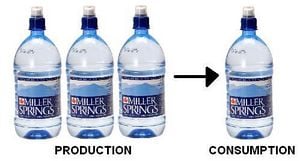
The production of plastic bottles requires energy, water (as well as money), resulting in many environmental consequences. One of these impacts is water usage: the water required to produce one bottle outweighs the water bottled for consumption in a ratio of three to one. In effect, two bottles of water are wasted for every bottle of water produced.[5]
| United States | Europe | Canada | Uruguay | |
|---|---|---|---|---|
| Fossil Fuels | 5902.75 | 4720.85 | 614.33 | 6.36 |
| Natural Gas | 1079.14 | 727.21 | 133.77 | 0.24 |
The energy required for production, as discussed above, also releases CO2 into the atmosphere. In 2006 more than a quarter million tons of CO2 was released into the air as a byproduct of bottled water.[5] That is approximately the same amount of CO2 produced due to the flaring of fossil fuels in Uruguay in the same year. Additionally, the United States consumes 16.7% of the bottled water production (based on data collected in 2004).[7] More energy is required to fill the bottles with water, transport to the consumer, refrigerate at the grocery stores or in homes, and disposal (garbage, reuse, recycle, etc.)
After the bottled water is consumed, approximately 14% of the bottles are recycled and the remaining bottles go to the landfills.[8] About two million tons of PET plastic bottles end up in landfills annually[9] (PET stands for polyethylene terephthalate which is a plastic resin found in food, drink, oil, and cosmetic packaging).
Also, many bottles are incinerated. Because of the chemical makeup of these bottles, burning plastic bottles causes a release of toxic byproducts including chlorine gas.
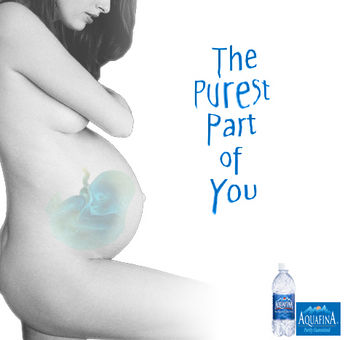
Health
One reason people choose bottled water are for it's media influenced image of purification. A study[11] executed by the Natural Resources Defense Council found that 47% of people drink bottled water because of the sanitation of tap water. In fact, there are health concerns for both tap and bottled water.
In addition, all-inclusive examinations of bottled water production standards are inexhaustive. The US Food and Drug Administration (FDA), who regulates bottled water in the United States, excludes 60 to 70% of all bottled water in it's monitoring processes due to state lines logistics.[4] Along the same lines, a lack of consistency was found among the actual water quality evaluations. The NRDC conducted another study[12] that found microbial levels exceeded accepted guidelines in one-fifth of the brands tested. Duration between health checks varies with tap and bottled water as well. The FDA requires the testing of a sample of bottled water for physical, chemical, and radiological contaminants once a year. The US Environmental Protection Agency (EPA) requires that water systems serving more than one million people have 300 water samples taken monthly to test for contamination.[4]
Aside from the quality of the water itself, the container can cause health concerns. Plastic bottles are suspect for leaching toxic chemicals into the water, including DEP, which is a phthalate and is potentially cancer-causing.
Past Events
The Movement
In order to spread awareness and take action against bottled water, Take Back the Tap has taken on and completed various projects so far. From permanent on-campus installations to educational socials to outside organization involvement, TBTT has worked to expand the scope and reduce HSU's consumption of bottled water. The following events have helped TBTT create a framework for their organization.
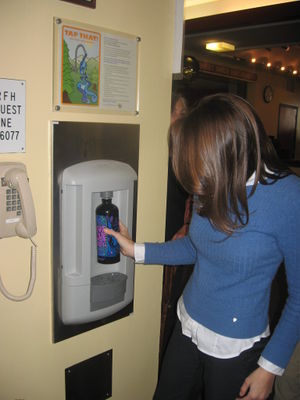
Campus Hydration Systems
Take Back the Tap recently wrote a HEIF (Humboldt Energy Independence Fund) grant proposal which sought to fund a hydration system on campus. They won a grant for one hydration station and received another by donation. The two HydrationStationsTM on campus are found in The Depot and in the Kinesiology & Athletics Building. The HydrationStationsTM process and purify tap water and they are free to use. The goal of the hydration systems is to reduce the sales of plastic bottles by 20 percent in three years. The reduction of plastic bottles sales equate to an off-set of 3,200 kg of carbon dioxide emissions.
Campus Recycling Program
Take Back the Tap worked to obtain a position in the Campus Recycling Program. The Campus Recycling Program, or CRP, offers education on recycling, as well as other conservation issues.
Day of Action
On October 14, 2009, TBTT had a Day of Action on campus at HSU. Three films were shown: Flow, Thirst and Liquid Assets. In addition, a panel was organized to discuss the effects plastic bottles have on indigenous people. Much of the plastic waste generated in the U.S is sent to foreign countries, mainly in Asia. These countries either recycle the plastic or dispose of the waste in landfills. Recycling plastic bottles causes chemicals to go into the air. Landfilling plastic bottles cause chemicals to leach into soil. The indigenous people are affected when they breathe contaminated air or are exposed to soil containing harmful chemicals.
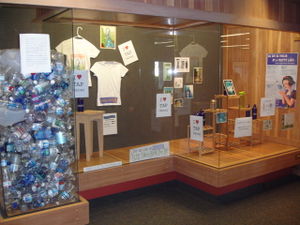
Library Display
At the beginning of the semester, TBTT put up a display in the HSU Library that received a lot of attention and feedback. In the display, TBTT included approximately 500 plastic bottles (see image on the right) providing a visual of how many plastic bottles are thrown away, as well as to discourage their use. The bottles used in the display were collected from campus a week before the semester formally began. Reusable bottles were featured on the opposite end of the display to encourage their use.
SLAM Fest
TBTT held a table at the Sustainable Living Arts and Music Festival (SLAM Fest). SLAM Fest is an event held once a year that promotes living sustainably by waste reduction and natural resource conservation.
Work with Associated Students Club
TBTT worked with Associated Students, a group who who speaks on behalf of all students, to create a resolution to support their efforts. In addition, Take Back the Tap persuaded A.S. members to offer a bottle-free alternative, a sustainable and non-plastic container, for the Brother Ali concert.
Ongoing Campus Activities
Take Back the Tap hosts a table on campus each week that offers the following:
- Reusable bottles and t-shirts for sale
- Volunteer sign-ups
- Education about the Take Back the Tap campaign, as well as the dangers of plastic bottles
Future Initiatives
Take Back the Tap has a many up-and-coming activities:
- In order to gain more knowledge and a better understanding, TBTT plans to conduct a campus-wide drinking fountain survey
- TBTT is also working to establish bottle-free zones as well as a Bottle-Free Day event in which people bring their own reusable containers
- Spring 2010 will bring about collaboration with Ann Alter’s TFD 477 Social Change New Media Production class. TBTT hopes to create short educational videos in order to inform others of the negative influences of bottled water
- Weekend workshops are scheduled for 2010 that offer lectures on various water issues and are open to the community
- In April 2010, TBTT will put up a second library display to educate visitors
- A Bottle-free day is planned where the use of reusable containers is encouraged
- TBTT is working on making "bottle-free" zones on campus in which the use of plastic bottles is forbidden
- TBTT will host an educational table at the 2010 SLAM Fest
- TBTT is planning on making the 2010 SLAM Fest a bottle-free event
Beth's Comments
- More links in your history section.
- CT4
- Be sure to review all conventions on the editing sheet. You are not referring to figures properly and you are not using captions properly. You need to cite and list references properly.
- W2 - search your document for "this"--this is also one, where feasible at least (some "this"es remain
- Check spelling--this is done, just be sure to spell-check again or spell carefull from here on out
- Paragraph under Library Display could be tighter
- Link to SLAM--i cannot find a good one
- review W1 "got" is on that list. Search your document and remove all gets and gots. Usually be and being are worth removing--done, again be cautious on these here on out
- Reword "the following can be found there" to be more specific and descriptive--i reworded it not sure if it still sounds bad
- Should your page be listed under HEIF as well?
References
- ↑ 2009, November 4. Stop the Consumption.
Retrieved on November 21, 2009 at The Lumberjack website:
http://www.thejackonline.org/opinion/editorial/stop-the-consumption-1.2049615 - ↑ 2.0 2.1 Schneider, Sarah. Email. 21 October 2009.
- ↑ Reese, John. 2009, July 25. The Other Way of Cleaning a Fish Tank.
Retrieved on November 20, 2009 on The Internet Journalist website:
http://www.theinternetjournalist.com/tag/fish/ - ↑ 4.0 4.1 4.2 Take Back the Tap. (2009). TBTT.
Retrieved November 11, 2009 from:
http://www.takebackthetap.org - ↑ 5.0 5.1 5.2 5.3 Pacific Institute. (2006) Bottled Water and Energy A Fact Sheet.
Retrieved from:
http://www.pacinst.org/topics/water_and_sustainability/bottled_water/bottled_water_and_energy.html - ↑ Grillot, Michael. (2009, August). International Energy Annual 2006.
Retrieved December 9, 2009 from EIA website:
http://www.eia.doe.gov/iea/carbon.html - ↑ Rodwan, John G. April/May 2004. Beverage Marketing Corporation.
Retrieved from Earth Policy Institute website:
http://www.earth-policy.org/index.php?/plan_b_updates/2006/update51 - ↑ Jones, Brian W. September 22, 2009. Unconsumption.
Retrieved on December 9, 2009 at Unconsumption website:
http://unconsumption.tumblr.com/post/194401912/only-14-of-plastic-water-bottles-are-recycled - ↑ Worldwatch Institute. (May 9, 2007). Bottled Water Pricey in More Ways than One.
Retrieved December 9, 2009 on Worldwatch Institute website:
http://www.worldwatch.org/node/5063 - ↑ Google Images. Yichi & Smashing Magazine. 2009, April 4. Aquafina - the Purest Part of You.
Retrieved from Vikiworks Infinity:
http://piyalisaha.com/wp-content/uploads/2009/04/aquafina-ad.jpg - ↑ Bottled Water: Pure Drink of Pure Hype? 1999, March. NRDC.
Retrieved on November 21, 2009 on NRDC website:
http://www.nrdc.org/water/drinking/bw/bwinx.asp - ↑ NRDC. Take Back the Tap: Health.
Retrieved on November 21, 2009 at Take Back the Tap website:
http://takebackthetap.org/learn/health/
- Fleeks, Brandi. 2009, November 13. Humboldt Students Take Back the Tap.
Retrieved November 15, 2009 at Humboldt State Now website:
http://now.humboldt.edu/news/humboldt-students-take-back-the-tap/ - DeLapp, Natalynne. HSU Takes Back the Tap.
Retrieved November 21, 2009 on North Coast Environmental Center website:
http://yournec.org/index.php?module=pagesetter&func=viewpub&tid=3&pid=681 - Earth Resource Foundation. Trash Talk: The Perils of Plastic.
Retrieved on November 21, 2009 on Polar Ice Capz Kidz Club website:
http://www.polaricecapz.com/trash_talk2_b.html
Acknowledgements
A special thanks to Sarah Schneider for all her input and pictures.